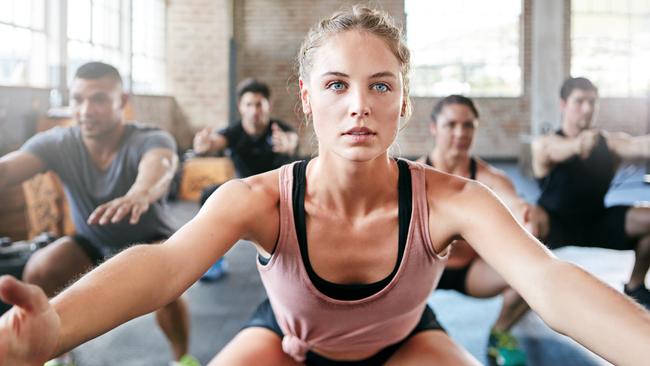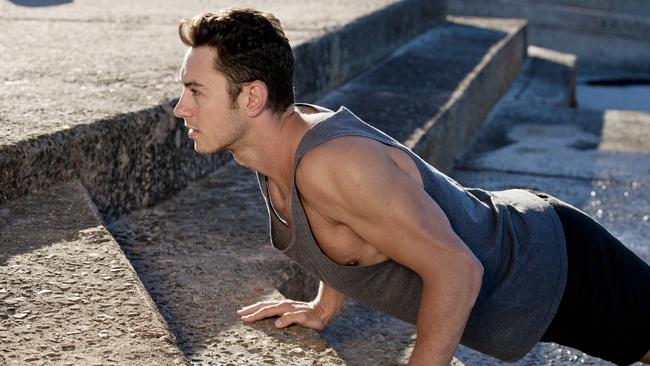Eight simple tests to check your fitness
From timing yourself climbing stairs to counting push-ups, here are eight simple tests to help you monitor your health.

After the marathon of festive indulgence, it is worth considering the fallout. Many of us are less fit than we think and, with the toll that the festive season has just taken on our bodies, January presents a mountain to climb in terms of returning to a respectable state of health.
“A lot of people would be surprised to learn that they would be classified as having a sedentary lifestyle, but inactivity is widespread,” says John Brewer, professor of applied sport science at St Mary’s University in Twickenham, London. “And levels of inactivity often slump to a new low around Christmas.”
Keeping tabs on your fitness levels is one way to stay on track. Exercise scientists have come up with several new tests to assess your status, and there are a couple of classics that will provide a great snapshot of your health. Brewer suggests doing the following tests every four to six weeks and keeping a log of the results. “They are a test, not a method of training, so don’t expect the test itself to get you fit,” he says. “You need to exercise regularly to see improvements in scores, but they can be a great source of motivation.”
How fast can you climb stairs?
The test: Time yourself climbing four flights of stairs. If you manage it in 45 to 55 seconds without stopping, you have a good fitness level. Under one minute is fine, but higher than that suggests you need to increase your gym work.
What it predicts: Risk of dying from cancer and heart disease.
How it works: Frequent stair-climbing has been linked to lowered blood pressure, reduced risk of disease and improved fitness in numerous studies.
The latest study to promote it as a must-do activity was published by the European Society of Cardiology this month after a study by a team of cardiologists from the University Hospital A Coruna in Spain. Led by the study author, Jesus Peteiro, they put 12,615 participants with known or suspected coronary artery disease through a treadmill test of their heart strength as measured by metabolic equivalents, or METs — one MET being the amount of energy needed to sit down and six METs the amount to jog slowly.
In the trial, those who could handle 10 METs of treadmill activity were deemed to have good “functional performance” and to be at a lower risk of dying from heart disease, cancer or other causes. However, a running machine isn’t necessary, the researchers emphasised; all you need is access to a flight of stairs.
“There are much cheaper ways to estimate if you could achieve 10 METs on the treadmill test,” Peteiro says. “If you can walk very fast up three floors of stairs without stopping or fast up four flights without stopping, you have good functional capacity. If not, it’s a good indication that you need more exercise.”
How long can you stand on one leg?
The test: Stand with your eyes open and raise one leg off the floor. Time how long you can maintain that position. Your aim is longer than 20 seconds.
What it predicts: Your risk of stroke, small blood vessel damage in the brain and reduced cognitive function as you age.
How it works: Research published in the American Heart Association’s journal Stroke three years ago showed how this simple test can reveal much about your cognitive function and brain health. A team from the Centre for Genomic Medicine at Kyoto University School of Medicine in Japan asked 841 women and 546 men with an average age of 67 to stand on one leg for as long as they could in three separate trials. They also had the health of their brain vessels evaluated using MRI scans.
The maximum time anyone managed the one-leg stand was 60 seconds, but those who wobbled before 20 seconds were found to have small blood vessel damage, which, said the associate professor Yasuharu Tabara, the study’s author, “may indicate an increased risk for brain disease and cognitive decline”.
When you can manage 20 seconds, try doing it with your eyes closed. According to the UK’s Medical Research Council, a study of people in their 50s showed that those who could stand on one leg for 10 seconds with their eyes closed were the most likely to be fit and well in 13 years. If they managed only two seconds, they were three times as likely to die before the age of 66.
How fast do you walk?
The test: Use an app such as Strava (or a stopwatch to time yourself over a measured distance) to find out how many kilometres you cover in an hour of walking. Your aim is a brisk pace of 5km/h to 7km/h (or 2.5km to 3.5km in a half-hour).
What it predicts: Your risk of heart disease.
How it works: In June last year, a study of 50,000 people by researchers at the University of Sydney, in collaboration with the universities of Edinburgh, Limerick and Ulster, showed that the quicker your walking pace, the lower your risk of cardiovascular disease, particularly as you get older. For the trial, the team analysed results of 11 surveys carried out on people who lived in Britain between 1994 and 2008 in which they reported their walking pace themselves. The results in the British Journal of Sports Medicine showed that fast walkers aged 60 or older had a 53 per cent lower risk of death from cardiovascular causes.
Walking at a brisk pace also was linked with a 24 per cent reduction in the risk of death from all causes across a 16-year period compared with dawdling, while an average pace also brought benefits, cutting the risk of mortality by about a fifth.
“A fast pace is generally 5km/h to 7km/h, but it really depends on a walker’s fitness levels,” says Emmanuel Stamatakis from the University of Sydney’s school of public health, who led the trial.
“An alternative indicator is to walk at a pace that makes you slightly out of breath or sweaty when sustained.”
Can you scratch your upper back?
The test: Place one hand behind the shoulder on the same side with the palm of your hand against your skin and fingers extended and the other hand behind the back, fingers extended. Ask someone to measure the number of centimetres your middle fingers are short of touching (a minus score) or overlapping each other (a plus score). Your aim is to try to get fingertips touching.
What it predicts: Upper-body flexibility and postural decline.
How it works: Kim Saha, a physiotherapist, says that too much sitting and slouching has a terrible effect on our shoulder flexibility. “Often we are unaware that we are becoming more hunched over our phones and our desks, and that it can have an impact on our future health,” Saha says.
“Failure to address a downturn in upper-body flexibility can cause serious problems and pain down the line.”
Neck and shoulder problems, such as “shoulder impingement”, a painful condition caused by tendons rubbing on bone in the limited space at the top of rounded shoulders, is common.
“And a hunched back puts pressure on the discs — the cushioning pads — between the bones of the lower back, so that they become compressed,” Saha says. “It can cause pain in the back, neck and pelvis.”
Keeping tabs on your flexibility is important, particularly for men. Researchers reporting in the Clinical Interventions in Ageing journal several years ago found that shoulder flexibility declines more rapidly in men than women; their results showed that, after the age of 60, women performed 20 per cent to 40 per cent better in the back-scratch test than men.
Can you do 30 squats in under a minute?
The test: The aim is to perform a deep squat — lowering your bottom as close to the floor as you can — 30 times in 45 to 60 seconds.
What it predicts: Overall cardio-respiratory fitness, flexibility and strength.
How it works: The squat test is a favoured measure of aerobic fitness among researchers, and two studies published last year — one by a team from the National Taiwan Normal University reporting in BioMed Research International and the other published in the journal PLOS One by medical experts at the University of Florida — hailed it as also being as effective, but simpler, than treadmill walking or step-ups. It’s widely used in many countries, including France, although in medical settings doctors will measure heart rate before and after the test to calculate your maximal oxygen uptake.
“Maintaining your ability to do squats is very important as you get to middle age and beyond,” says Dalton Wong, founder of Twenty Two Training.
“Performed in quick succession, they will work your heart and lungs, but the exercise also engages the major muscles in the lower body, improving posture, strength and range of movement.”
How fat are you?
The test: Calculate your BMI (body mass index) by dividing your weight (in kilograms) by the square of your height (in metres). Below 18.5 is underweight, 18.5 to 24.9 is healthy, above 24.9 is too heavy, and above 30 is obese.
What it predicts: Your overall health risk.
How it works: Using BMI as a measure of fitness and health drifts in and out of vogue in the medical profession.
It’s controversial because it doesn’t take into account muscle mass and distribution, but the latest study, conducted by epidemiologists at the University of Bristol, suggests that it is as accurate as fat testing for predicting some health problems.
Joshua Bell, who led the study, analysed a trial of 2840 people and found that those who had a higher total body fat and a high BMI at ages 10 and 18 were linked with “damaging levels of cardiometabolic traits”, such as raised blood pressure and adverse cholesterol and inflammatory profiles, when they reached adulthood.
“BMI is often criticised,” Bell says. “Our study asked how useful it really is for detecting the health effects of obesity by pitching it against more objective body scan measures.” He says that the results, published recently in the Journal of the American College of Cardiology, confirmed that “simple BMI gives very similar answers to more detailed measures” yet costs “virtually nothing”.
How many push-ups without stopping?

The test: Perform as many consecutive full push-ups as you can without stopping, then compare your score with the American College of Sports Medicine tables below.
What it predicts: Cardio-metabolic health and frailty or risk of falling as you get older.
How it works: “Push-ups are a measure of strength endurance, a combination of pure strength and the sort of endurance you need for aerobic exercise like running, swimming and cycling,” Brewer says. “Because they engage muscles in the legs, core and upper body, push-ups are considered a supreme all-round exercise and your ability to perform them is a good pointer towards your overall fitness.” If you are unable to do a full press-up, try modified ones with your knees on the ground.
Scores
Ages 20 to 29:
Men: 36 (excellent), 28 (good),
16 (needs improvement)
Women: 30 (excellent), 20 (good), 9 (needs improvement)
Ages 30 to 39
Men: 30 (excellent), 21 (good),
11 (needs improvement)
Women: 27 (excellent), 19 (good),
7 (needs improvement)
Ages 40 to 49
Men: 25 (excellent), 16 (good),
9 (needs improvement)
Women: 24 (excellent), 14 (good), 4 (needs improvement)
Ages 50 to 69
Men: 21 (excellent), 10 (good),
6 (needs improvement)
Women: 21 (excellent), 10 (good),
1 (needs improvement)
Ages 60 to 69
Men: 18 (excellent), 10 (good),
4 (needs improvement)
Women: 17 (excellent, 11 (good),
1 (needs improvement).
The sit-and-rise test
The test: Stand upright with clear space around you. Without leaning on anything, lower yourself to a sitting position on the floor. Then stand back up, trying not to use your hands, knees, forearms or sides of your legs.
Start with 10 points and subtract one point for putting a hand, forearm or knee on the floor and another point for putting a hand on your knee. If you lose balance subtract 0.5 of a point. Tally your final score.
What it predicts: Flexibility, balance, muscle strength and longevity.
How it works: Brazilian scientists reporting in the European Journal of Preventive Cardiology in 2012 used this simple test to predict the longevity of more than 2000 people aged 51 to 80.
Those who scored fewer than eight points in the test were found to be twice as likely to die within the next six years compared with those who scored a higher number of points.
People who scored three or fewer points were more than five times as likely to die within the same period compared with those who scored more than eight points.
The Times


